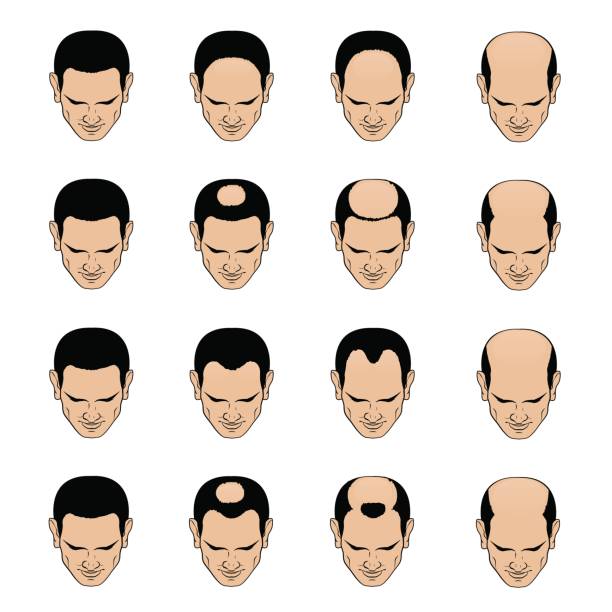Male Pattern Baldness (MPB) is prevalent in millions of men worldwide; however, many biases and myths are associated with it.
MPB can cause a wealth of psychological or emotional impacts to people affected by it, from minor hair loss to severe baldness.
However, by increasing awareness and information on this particular illness, men can diagnose the signs, seek treatment, and embrace the quirks of their gender proudly.
Hair loss on the scalp commences at the crown or temples and becomes generalized, thereby defining this condition.
MPB follows a particular pattern, and hair loss often transforms into the shape of the letter “M” as the crown develops and the hairline recedes.
Even though MPB does not cause complete baldness, the affected person’s quality of life and self-esteem may be negatively affected.
It is essential to share information on male pattern baldness for several reasons. First, most men may not know that hair loss is more than just a cosmetic concern; it could be a sign of some diseases or even genetics.
Common techniques include FUE and FUT transplantation Both methods provide a long-term fix by transferring hair follicles from thick areas to balding areas. Speak with an expert to find the best course of action for you.
What is Male Pattern Baldness?
Explanation of Male Pattern Baldness (MPB):
Male Pattern Baldness (MPB), known as androgenetic alopecia, is a typical hair loss primarily affecting men. It is characterized by progressive hair thinning on the scalp, which often starts at the temples or head and gradually extends outward. MPB has a distinct pattern, with hair loss usually regressing to a recognizable “M” as the crown becomes more prominent. While MPB seldom causes complete baldness, it can significantly negatively impact a person’s self-esteem and quality of life.
Key Features and Characteristics:
Prevalence and Statistics
Male Pattern Baldness is incredibly common, affecting millions of men worldwide. According to statistics, MPB affects approximately:
- By age 35, about 40% of men will have noticeable hair loss.
- By the age of 50, approximately 50% of men will experience significant hair loss.
- By 60, about 65% of men will have moderate to extensive hair loss.
Male Pattern Baldness can strike at any age; however, it is more common in older men. Some men may noticeably start to lose hair in their twenties or thirties. MPB is mainly influenced by genetic susceptibility, with family history frequently serving as a reliable indicator of the likelihood of hair loss.
Causes of Male Pattern Baldness:
- Genetics:
- Androgens:
- Hair Growth Cycle:
Feel free to expand on these points or add any other relevant information to create a comprehensive section on the causes of male pattern baldness!
Identification and Diagnosis of male pattern baldness

Symptoms of Male Pattern Baldness
- Receding Hairline:
- One of the earliest signs is a receding hairline, typically starting at the temples. The hairline gradually moves backwards, forming an “M” shape.
- Thinning Crown:
- Men with male pattern baldness often notice thinning at the crown (top) of their head. The hair becomes finer and less dense.
- Visible Scalp:
- The scalp becomes more visible as hair continues to thin, especially under bright light or when wet.
- Miniaturization:
- Hair strands become finer and shorter due to the miniaturization of hair follicles. This results in a less robust appearance.
- Bald Patches:
- Eventually, bald patches may develop, especially at the crown or near the back of the head.
Diagnosing Male Pattern Baldness
Clinical Assessment:
Family History:
Rule of Two-Thirds:
Scalp Biopsy (Rare):
Remember that male pattern baldness is a gradual process; early intervention can help manage it effectively. If you suspect hair loss, consult a healthcare professional for personalized advice and treatment options.
To keep an eye on changes and the efficacy of therapies, take regular pictures of your scalp.
Risk factors and who is at risk for Male Pattern Baldness:
Risk Factors
- Age:
- Genetics:
Who’s at Risk?
- Men:
- Certain Ethnic Groups:
Awareness of these risk factors can help people control their hair loss proactively. If you’re concerned about male pattern baldness, speak with a healthcare specialist for personalized advice and possible.
Prevention and coping strategies for male pattern baldness:

Lifestyle Changes
- Healthy Diet:
- Nutrient-rich foods: Consume foods rich in vitamins (especially vitamin D and biotin), minerals (like zinc and iron), and protein. These nutrients support for hair health.
- Omega-3 Fatty Acids: Include sources like fish, flaxseeds, and walnuts to promote scalp health.
- Stay Hydrated: For fine hair development, enough hydration is necessary.
- Stress Management:
- Chronic Stress and Hair Loss: Excessive stress might make hair loss worse. Engage in relaxing exercises like yoga, meditation, and deep breathing.
- Adequate Sleep: Lack of sleep affects hormonal balance, potentially contributing to hair thinning.
- Avoid Harsh Hair Treatments:
- Heat Styling: Excessive use of hairdryers, straighteners, and curling irons can damage hair follicles.
- Chemical Treatments: Limit exposure to harsh chemicals (e.g., dyes, perms) that weaken hair.
- Tight Hairstyles: Avoid tight ponytails or braids that pull on the hair.
Medical Treatments
Male pattern baldness, also understood as androgenetic alopecia, is a prevalent reason for hair loss in men. Below are some of the most effective medical treatments:
Minoxidil (Rogaine)
- Description: An over-the-counter topical solution or foam you apply to the scalp.
- How it Works: It stimulates hair follicles to promote growth and slow hair loss.
- Effectiveness: Effective for many men, mainly when used consistently. Results may take a few months to appear.
Finasteride (Propecia)
- Description: A prescription oral medication.
- How it Works: It blocks the conversion of testosterone to dihydrotestosterone (DHT), a hormone that shrinks hair follicles.
- Effectiveness: Shown to reduce hair loss and stimulate regrowth in many men. Results can take several months to become noticeable.
Dutasteride (Avodart)
- Description: A prescription oral medication similar to Finasteride but more potent.
- How it Works: It inhibits both forms of 5-alpha-reductase, which turns testosterone to DHT.
- Effectiveness: It can be more effective than Finasteride in some cases, but it’s not FDA-approved for hair loss treatment in the U.S.
Low-Level Laser Therapy (LLLT)
- Description: A non-invasive treatment using laser devices such as combs, helmets, or caps.
- How it Works: The laser light stimulates hair follicles, increasing energy production and improving cell function.
- Effectiveness: Studies suggest it can help improve hair density and overall health when used consistently.
Platelet-Rich Plasma (PRP) Therapy
- Description: A medical procedure involving platelet-rich plasma injections derived from the patient’s blood.
- How it Works: PRP injections stimulate hair growth by promoting healing and tissue regeneration.
- Effectiveness: Some studies indicate it can be effective, but more research is needed to understand its benefits and mechanisms fully.
Hair Transplant Surgery
- Description: A surgical procedure where hair follicles are moved from a donor area (usually the back or sides of the head) to the balding area.
- How it Works: Hair is transplanted using Follicular Unit Transplantation (FUT) or Follicular Unit Extraction (FUE) techniques.
- Effectiveness: This procedure provides permanent and natural-looking results. It’s a more invasive option but can be very effective for long-term hair restoration.
Microneedling
- Description: A procedure involving a fine needle device to create tiny scalp punctures.
- How it Works: The micro-injuries trigger the body’s healing response, potentially stimulating hair growth.
- Effectiveness: Often combined with other treatments like Minoxidil for enhanced results.
Combining these therapies can frequently produce the best outcomes, but it is critical to see a healthcare expert to decide which approach is best for your specific needs and symptoms.
In addition to lowering stress and enhancing general health, regular physical activity may also benefit hair health.
Living with Male Pattern Baldness:
Psychological Impact and Emotional Well-being:
Support Groups and Resources for Men with MPB:
Embracing Self-confidence and Individuality:
Reducing follicle damage and averting deficiencies that can cause hair loss are two ways that quitting smoking and alcohol intake improves blood circulation and nutritional balance, which benefits hair health.
Conclusion
living with Male Pattern Baldness (MPB) presents physical and emotional challenges, but it’s important to remember that you are not alone in your journey. By addressing the key points discussed, we hope to provide support and guidance for men navigating the complexities of MPB.
Recap of Key Points Discussed:
- Male Pattern Baldness (MPB) is a common condition characterized by progressive hair loss, typically starting at the temples or crown.
- It is essential to seek expert assessment from dermatologists or other healthcare practitioners to diagnose MPB and receive individualized treatment accurately.
- Even though MPB can have a major psychological impact, it’s important to acknowledge the emotional difficulties and get help from loved ones, friends, or mental health specialists.
- Support groups, resources, and online communities are available to provide guidance, information, and a sense of belonging for men living with MPB.
- Embracing self-confidence and individuality, shifting focus from perceived flaws, and surrounding yourself with supportive individuals are essential steps in coping with MPB.
Encouragement for Seeking Professional Help:
We urge you to look into individualized treatment options and seek professional assistance if you exhibit Male Pattern Baldness symptoms. Early action can improve results and slow down the pace of hair loss, giving you back your confidence and preserving healthy hair growth.
Message of Hope and Empowerment for Men Living with MPB:
Living with Male Pattern Baldness may present challenges, but it’s important to remember that your worth extends far beyond your appearance. You are more than your hair; your unique qualities, talents, and accomplishments define you. Embrace self-confidence, seek support from others, and remember that you have the strength and resilience to navigate the journey of living with MPB with grace and confidence.
Together, we can challenge stereotypes, promote acceptance, and empower men to embrace their individuality and live life to the fullest, regardless of hair loss.
FAQs about Male Pattern Baldness:
What causes male pattern baldness?
Genetics: Family history plays a significant role. If close relatives (especially parents or siblings) experienced male pattern baldness, you’re more likely to be at risk.
Androgens (DHT): Male sex hormones, particularly dihydrotestosterone (DHT), affect hair follicles, leading to miniaturization and eventual hair loss.
Hair Growth Cycle Changes: The growth cycle weakens over time, resulting in thinner and shorter hair strands.How can I identify male pattern baldness?
Look for common signs:
– Receding hairline (often forming an “M” shape).
– It was thinning at the crown (top) of the head.
– Visible scalp due to hair loss.
Doctors diagnose it based on hair loss patterns and family history.Can lifestyle changes help prevent hair loss?
Yes! Consider:
Healthy Diet: Nutrient-rich foods support hair health.
Stress Management: Chronic stress can worsen hair loss.
Avoid Harsh Treatments: Limit heat styling and chemical treatments.What medical treatments are available?
Minoxidil (Rogaine): A topical solution that promotes hair growth.
Finasteride (Propecia): An oral medication that inhibits DHT production.
Hair Transplants: Surgical procedures to transplant hair follicles.Does Male Pattern Baldness affect everyone the same way?
No, Male Pattern Baldness can vary in severity among individuals. Some men may experience mild hair thinning, while others may develop more extensive baldness. Factors such as genetics, hormone levels, and lifestyle habits can influence the progression of MPB.
Is Male Pattern Baldness hereditary?
Male Pattern Baldness often has a vital genetic component and tends to run in families. Individuals with a family history of hair loss, particularly on the maternal side, are at a higher risk of developing MPB.
Is Male Pattern Baldness reversible?
While treatment options can help slow down hair loss progression and promote hair regrowth, Male Pattern Baldness is generally considered a progressive condition. Early intervention with appropriate treatments can yield better outcomes, but complete reversal of hair loss may not always be possible if you try hair transplants.

